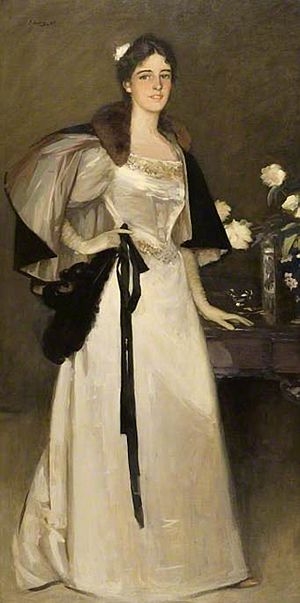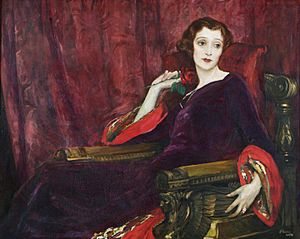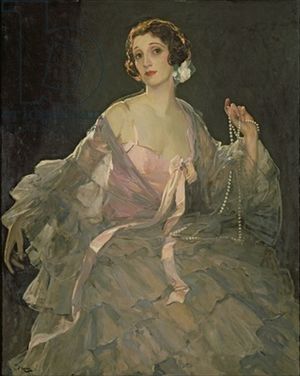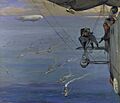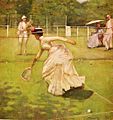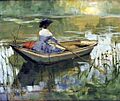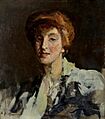John Lavery facts for kids
Quick facts for kids
Sir John Lavery
|
|
|---|---|
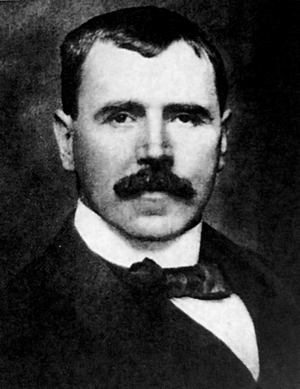 |
|
| Born | 20 March 1856 Belfast, County Antrim, Ireland
|
| Died | 10 January 1941 (aged 84) Kilmoganny, County Kilkenny, Ireland
|
| Resting place | Putney Vale Cemetery |
| Nationality | Irish |
| Alma mater | Haldane Academy |
| Known for | portraits and wartime depictions |
| Spouse(s) | Kathleen MacDermott (1889–1891) Hazel Martyn (1909–1935) |
Sir John Lavery (born March 20, 1856 – died January 10, 1941) was a famous Irish painter. He is best known for his amazing portraits of people and his paintings that showed scenes from wartime.
Contents
Life of a Famous Artist
Early Life and Learning to Paint
John Lavery was born in Belfast, Ireland. When he was still a child, he moved to Scotland. There, he went to the Haldane Academy in Glasgow in the 1870s to study art.
In 1878, he opened his own art studio. Sadly, it burned down the next year. With the money he got from insurance, he spent a year studying at Heatherley's School in London.
Lavery continued his art studies in Paris in the early 1880s at a famous school called the Académie Julian.
Becoming a Well-Known Painter
After his studies, Lavery returned to Glasgow. He became part of a group of artists known as the Glasgow School. A rich shipowner named William Burrell was a big supporter of Scottish artists, including Lavery.
In 1888, Lavery got a very important job. He was asked to paint Queen Victoria's visit to the Glasgow International Exhibition. This painting helped him become a well-known artist who painted important people. Soon after, he moved to London.
In London, he became good friends with another famous painter, James McNeill Whistler. Whistler's style of painting influenced Lavery's work.
Painting During Wartime
Like another artist named William Orpen, Lavery was chosen to be an official artist during the First World War. This meant he would paint scenes from the war. However, he was not very healthy, so he could not travel to the battlefields.
He also had a serious car crash during a Zeppelin bombing raid. This made it even harder for him to do his job as a war artist. He stayed in Britain and mostly painted boats, airplanes, and airships.
During the war, he was close friends with the Asquith family. He spent time at their home by the River Thames, painting their portraits and peaceful scenes like Summer on the River.
After the War and Recognition
After the war, John Lavery was given the title of "Sir" for his achievements. In 1921, he was chosen to be a member of the Royal Academy, a very important art institution. His paintings were even part of the art competitions at the Olympic Games in 1924, 1928, and 1932.
Involvement in Irish History
During this time, Lavery and his wife, Hazel, were involved in the Irish War of Independence and the Irish Civil War. They let Irish negotiators use their London home during important talks that led to the Anglo-Irish Treaty.
After an Irish leader named Michael Collins was killed, Lavery painted a famous picture called Michael Collins, Love of Ireland. This painting is now in the Hugh Lane Municipal Gallery in Dublin.
In 1929, Lavery gave many of his paintings to both The Ulster Museum and the Hugh Lane Municipal Gallery. In the 1930s, he moved back to Ireland. He received special degrees from universities in Dublin and Belfast. He was also made a "freeman" of both Dublin and Belfast, which is a special honor.
Family Life
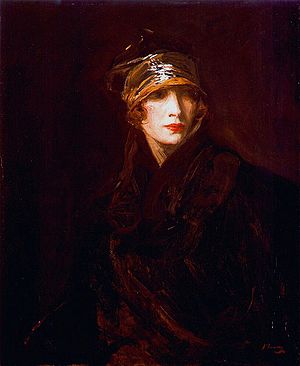
John Lavery grew up without his parents and was raised by relatives.
He married his first wife, Kathleen MacDermott, in 1889. Sadly, she died in 1891, shortly after their daughter, Eileen, was born.
In 1909, Lavery married again to Hazel Martyn. She was an Irish-American woman known for her beauty. Hazel had a daughter named Alice from a previous relationship.
Hazel Lavery was a very important model for her husband. She appeared in more than 400 of his paintings! One famous painting is The Artist's Studio: Lady Lavery with her Daughter Alice and Step-Daughter Eileen. It is now in the National Gallery of Ireland.
Hazel Lavery also modeled for a painting that represented Ireland. This painting was used on Irish banknotes from 1928 until 1975.
Sir John Lavery passed away in Kilmoganny, Ireland, on January 10, 1941, at the age of 84. He was buried in Putney Vale Cemetery.
Where to See His Art
You can find Sir John Lavery's paintings in many art galleries and museums around the world. Here are some of them:
- Aberdeen Art Gallery
- Birmingham Museum & Art Gallery
- The Crawford Municipal Art Gallery, Cork
- The Guildhall Art Gallery, London
- The Hugh Lane Municipal Gallery, Dublin
- The Imperial War Museum
- The Irish Museum of Modern Art (IMMA)
- The Laing Art Gallery
- The National Gallery of Ireland, Dublin
- Rothe House, Kilkenny
- National Museum of Serbia, Belgrade
- The Tate Gallery, London
- The Ulster Museum, Belfast
- The Walker Art Gallery, Liverpool
Images for kids
See also
- List of Irish artists



